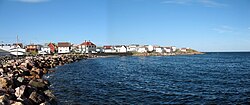Grand Bank, Newfoundland and Labrador
| Grand Bank | ||
|---|---|---|
| Town | ||
 |
||
|
||
| Location of Grand Bank in Newfoundland | ||
| Coordinates: 47°06′N 55°47′W / 47.100°N 55.783°W | ||
| Country |
|
|
| Province |
|
|
| Settled | 1640 | |
| Incorporated | 1943 | |
| Government | ||
| • Type | Town Council | |
| • Mayor | Rex Matthews | |
| • MHA |
Darin King Ph.d, (P.C.), Grand Bank (electoral district) |
|
| • MP |
Judy Foote (LIB), |
|
| Area | ||
| • Total | 16.97 km2 (6.55 sq mi) | |
| Elevation | 7 m (23 ft) | |
| Population (2006) | ||
| • Total | 2,580 | |
| • Density | 152.03/km2 (393.89/sq mi) | |
| down 9.19% since 2001 (2841) | ||
| Time zone | Newfoundland Time (UTC-3:30) | |
| • Summer (DST) | Newfoundland Daylight (UTC-2:30) | |
| Area code(s) | 709 | |
| Highway 220 | French Island Drive | |
| Website | The Town of Grand Bank | |
Judy Foote (LIB),
Grand Bank, Newfoundland and Labrador, Canada or 'Grand Banc' as the first French settlers pronounced it, is a small rural town with a population of 2,580. It is located on the southern tip or "toe" of the Burin Peninsula (also known as "the boot"), 360 km from the province's capital of St. John's.
Grand Banc was inhabited by French fisherman as early as 1640 and started as a fishing settlement with about seven families. It was given the name "Grand Banc" because of the high bank that extends from Admiral's Cove to the water's edge on the west side of the harbour.
The Town of Grand Bank can attribute much of its past and present growth and prosperity to its proximity to the fishing grounds and its ice-free harbour. Original settlers thrived on trade with the French and a vigorous inshore fishing industry. Grand Bank became the nucleus of the bank fishing industry for Newfoundland and a service centre for Fortune Bay. With the decline of the salt fish industry, the town's emphasis quickly shifted to fresh fish production. Enterprising businessmen and town planners prepared the way for a fresh fish plant (present day Grand Bank Seafoods Inc.) and a fleet of trawlers.
1640 - French fishermen were said to be in Grand Bank during this time.
1687 - First French Census taken in Newfoundland shows “Grand Banc” with a population of 45 (39 servants, 2 masters, 3 women and 1 child). The first community had one church, 3 houses and 18 muskets.
1693 – Census takers recorded some of the prominent names: Bourney, Commer, Chevallier and Grandin.
1713 - Treaty of Utrecht, France relinquishes its claim to Newfoundland including St. Pierre et Miquelon. The French Population moved to Ile Royale (Cape Breton).
1714 - William Taverner surveys the coast for the English Government.
1763 - Peace Treaty of Paris: French are given St. Pierre et Miquelon, forcing the English population at St. Pierre to relocate to Grand Bank and Fortune Bay. First record of English settlement.
1765 - Captain James Cook mapped out the area and moored his ship at Admiral’s Cove. Came ashore and gathered buds off the small spruce tree to brew beer (excellent source of vitamin C) for his crew.
1836 – Census list 45 dwellings and a population of 236 residents.
...
Wikipedia


